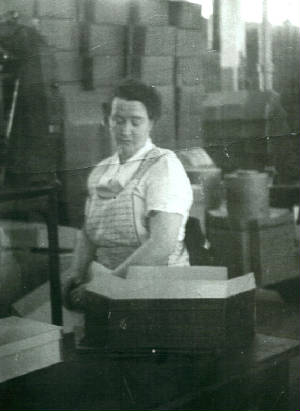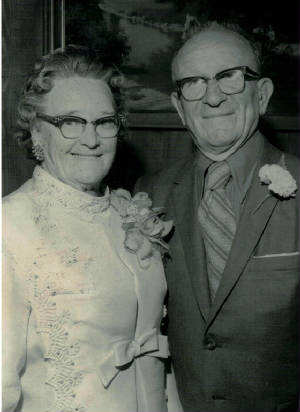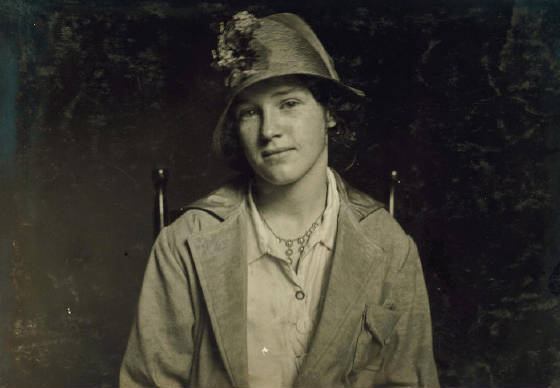
Lewis Hine caption: Evelyn Casey, 129 Gaynore St., 14 years, 6 months – Irish. Went to work on 14th birthday cleaning harnesses in Borden Mills. Left because of no work and expects to learn weaving in Flint mill with a girl friend. At certificate office applying for certificate for second position. Location: Fall River, Massachusetts, June 17, 1916.
“She had a lot of hats, and they were all different styles. She was good for wearing a hat.” -Joanne Potvin, daughter of Evelyn Casey

Shortly after the Civil War, Fall River, later to be justifiably called the “Spindle City,” was the leading textile city in the country, and remained so until the 1920s. In the early 1870s, 15 new manufacturers and 22 mills were established in the city, causing a population boom of almost 20,000 more residents, mostly Irish and French-Canadian immigrants. Over 12,000 units of company housing were built, mostly three-story tenements known commonly as “triple deckers.”
When I saw the top photo of Evelyn, it was her hat that caught my eye first, then her lovely Irish face. She looked spunky and full of optimism, and I wondered if she got the job she was applying for. But I ran into problems right away.
One of the most important keys to my search for the life of a child laborer is to find out when and where the person died. With that information, I can usually obtain the obituary, and thereby learn the names of the survivors, such as children or grandchildren. That’s a big hurdle to cross when the subject is a girl, because without her married name, I have no idea what her name was when she died. Unfortunately, most states, including Massachusetts, do not post their marriage records on the Web. After finding Evelyn in the 1910 census, I ran into a brick wall. I assumed that if she didn’t appear in the 1920 census, she either had died or married by then. So I tried a different approach. I contacted the Herald News, the newspaper in Fall River.
Reporter Marc Dion took an interest right away, and on April 6, 2008, Evelyn’s picture was published, along with Dion’s article, under in the headline: “Who Was Evelyn Casey?” He wrote, in part:
“A closer look at the pictures show that the edge of her hair ribbon is frayed, that her coat doesn’t hang quite right and, though she is prosperous enough to wear a necklace, she also wears a blouse that looks like it’s been worn and washed too many times. Evelyn Casey left history after that photograph, walked back into the mill yard, walked back into the tenement streets, waded back into Fall River’s multi-tongued ethnic stew.”
“Who was Evelyn Casey? That’s the question … that haunts Joe Manning. The Fall River Historical Society found one Evelyn Casey who seems like an almost perfect match for the girl in the photo. This Evelyn Casey was born around 1902, which would have made her the same age as the girl in the photograph. The Evelyn Casey of the city census is listed as having two addresses between 1910 and 1919. In 1910, she, her parents and six siblings lived at 52 Covel St. By 1919, they lived at 176 Horton St. There is no Gaynore Street in Fall River, or if there was, its name has not survived. But some other things about the Evelyn Casey of the census records go well with the girl in the photograph.”
“There’s the age, of course, but there’s also the fact that the girl in the photograph was looking for work as a weaver in 1916. In 1919, records show an Evelyn Casey working as a weaver. The photograph’s caption identifies Evelyn Casey as an Irish girl. Documents at the Historical Society say their Casey was second generation American, her grandparents having immigrated from Ireland.”
“Evelyn Casey continued to be listed in city directories as a weaver living with her parents until 1922, when she may have married and taken her husband’s last name. Are the Evelyn Casey in the photo and the Evelyn Casey in the records the same woman? It’s a good bet, but there’s probably someone out there who knows for sure. Do you remember Evelyn Casey?”
Three days after the newspaper article appeared, I received an email from a woman named Paula Geary. She said, in part:
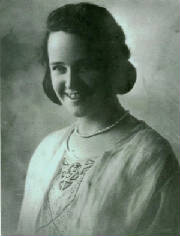
“While reading the article about Evelyn Casey in the Herald News, I had the feeling that the story was familiar. I went to my computer and entered the name Evelyn Casey into my family tree database…and there she was! I was so excited to see that she was the sister of my Aunt Mary.”
“I never knew any of Mary’s family, but I did know that they were a large, Irish family. While researching Mary’s family, I found that Evelyn had married a Simonetti. I’ve attached the research that I have on the family. It will give you a little glimpse into what life was like in Fall River at the turn of the century.”
Shortly after, I was contacted by Joanne Potvin, Evelyn’s daughter, who had also read the article. I interviewed her several weeks later.
Evelyn V. Casey was born in Fall River, Massachusetts, on November 22, 1901, the fourth child of Michael Joseph Casey and Johanna (Harrington) Casey. They married in Fall River on October 9, 1893. Evelyn married Alfred L. Simonetti in 1922. They had four children.
Edited interview with Joanne Potvin (JP), daughter of Evelyn Casey. Conducted by Joe Manning (JM), on April 22, 2008. Transcribed by Jessica Sleevi and edited by Manning.
JM: What did you think of the photo of your mother?
JP: I had seen it once before. I had gone down to Battleship Cove (ship museum in Fall River) to see the USS Massachusetts. I went into the gift shop and saw a book about weavers and spinners in the textile mills. I was glancing through it and saw the picture. I thought, ‘Oh God, it’s my mother.’ And then recently, you got the Herald News to publish the picture. So I’m sitting at the table and ready to go to work, and I said, ‘What is my mother’s picture doing in the paper?’ And then I read your article and I thought it was unbelievable.
JM: Did she ever mention to you that she worked as a young child in the mill?
JP: No. I only knew of her working for the American Thread Company, which was located in the Kerr Mills. It was right near our house. She was called a corner stayer. When you put a box together, you have tape to hold the corners. She put the tape on the corners of the box. That’s what her machine used to do.
JM: So she was doing that when you were growing up?
JP: I was born in 1932. When I was young, she stayed home for awhile. Then she went back to work when I was about eight or nine years old.
JM: Did she go back because your family needed the money?
JP: Yes. My father worked on a National Biscuit Cookie truck, and he wasn’t making much money. They had bought a home and had four children. I was the youngest of the four.
JM: Do you think that she welcomed the opportunity to go back to work, or do you think that she didn’t want to do it?
JP: I really don’t think that she wanted to go back. She would have rather stayed at home with the children, although when I was eight, my brothers were already 14, 16 and 19. She assigned tasks to us children while she worked. I had to do the cleaning on the first floor, and my brother had to do the second floor. I had to do the wash and another brother did some cooking, and then I took over all the cooking. She would go to work at six o’clock in the morning and get home after five at night. She worked there until it closed down, I think sometime before 1950. So she stayed home for awhile and then went to work at the Slater Paper Box Company in Warren, Rhode Island. The children were all grown up by that time.
JM: Do you know anything about Borden Mills, where she had worked when the picture was taken? Did you have any other family members who worked there?
JP: No, but I found two pictures of her working at the Wampanoag Mill (textile mill that closed in 1929). These were group pictures from work, probably taken by the company. She must have left the Borden Mills and went to the Wampanoag Mill.
JM: In the Hine photo, the caption says she lived at 129 Gaynore Street.
JP: I don’t remember that. I only remember her living on Covel Street.
JM: Also in the caption, it says: “Left because of no work and expects to learn weaving in Flint mill with a girl friend. At certificate office applying for certificate for second position.”
JP: I don’t know anything about that, either. I don’t know much about her life before she married my father.
JM: One of the things that struck me about the photograph was the hat she was wearing. Did you recognize that hat?
JP: No, but she had a lot of hats, and they were all different styles. She was good for wearing a hat.
JM: She probably wore the hat to the job interview.
JP: Well, she was very adamant about looking good. And that’s what I take that hat meaning, that she wanted to make an impression on whoever she was going to see.
JM: The picture is quite stunning. Your mother is very beautiful in this picture.
JP: Yes, she was.
JM: And very Irish-looking.
JP: Her mother was really Irish-looking, too.
JM: Do you think that your mother was regarded as beautiful by other people?
JP: She never mentioned that. All she used to say was that she had big teeth when she smiled and she hated it. She said it spoiled her face.
JM: I’ve got the 1910 census information here, and your mother is listed as eight years old.
JP: That would be correct.
JM: Her father and mother are listed as Michael and Johanna.
JP: That’s right, too.
JM: And the children listed are Francis, Margaret, Evelyn, Edward, Angela, Joseph, and Mary.
JP: There were more children, a total of 10. Gertie, the oldest one, died young. And there was Anna, then also Arthur, who died right after he was born.
JM: Did your mother ever talk much about what her life was like when she was a child?
JP: We never discussed that.
JM: Did you ever talk to your grandparents about that?
JP: No. My grandfather passed away before I was born. I remember going down to my grandmother’s a lot, but she wasn’t a talkative person. She never told us stories. My mother would tell us stories sometimes, but I guess we didn’t pay attention to her then. When you’re older, you realize that you should have paid attention.
JM: Where was the house that you grew up in?
JP: At 114 Walker Street, in Fall River, where I’m living right now.
JM: Your mother was Irish. Was it an Irish neighborhood?
JP: Yes, with a big Catholic parish, Immaculate Conception. She was born and brought up in that parish. She got married in that parish. And, of course, when she passed away, she was buried in that parish, and all the children were baptized and had first communion and everything there.
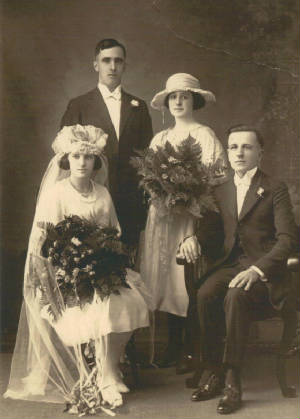
JM: Your father was named Alfred Simonetti. I assume he was Italian. Wasn’t that a bit unusual for your mother to have married an Italian?
JP: Her parents didn’t want it. When he first met her, he knew her parents didn’t want her to have anything to do with Italians, so he called himself Harold Green.
JM: I imagine he probably didn’t look exactly like a Harold Green.
JP: No, he didn’t. He had the dark hair, but he had blue eyes. They got married in 1922. She was 20 and he was 22. He worked for National Biscuit for a few years and then went to work for the Eastern Massachusetts Street Railway, which operated the buses here in the city. He was a mechanic and fixed the buses. Then they laid him off, so he worked for my uncle for awhile in a package store. And then he was going to be laid off, but he was 65, so he quit. The last job my mother had was the one for Slater Box, but I don’t remember when she retired. She passed away in 1973, about six months after their 50th wedding anniversary. My father passed away two-and-a-half years later.
JM: Had she been ill for awhile?
JP: Yes. She had found out in January of 1972 that she had cancer. She wanted to celebrate her 50th wedding anniversary, so we gave her something special. My brothers and I gave my parents money so they could travel to Europe. We sent them to Ireland, England, Italy, all those places. They went to 10 countries. They were gone three weeks, but when they came back, she wasn’t well at all. And then in the following year they operated on her, and then told her she had six months, and that’s how long she lived.
JM: What was your mother like?
JP: She was easy going, but she was stern in her own ways. She never promised us children things that we asked for. She’d say, ‘I’ll see.’ And then, when the time came she’d say, ‘Sorry, I can’t do it.’ That way, she never had to go back on a promise. And she used to say to us: ‘Don’t lie to me. I don’t lie to you, so don’t lie to me.’ My father was a very quiet man. He would sit in the background, and if you asked him a question, he’d answer it. But my mother was talkative, and she had a lot of friends. When she passed away, the undertaker was surprised how many people came. It was standing room only.
JM: What did your mother like to do for recreation?
JP: She loved to sew. She made suits and stuff for my brothers. She and my father went for long rides, and when my father was working sometimes and she was home, I would take her out for rides. She loved going different places, not knowing where she was going. She used to have the family in every weekend, and they would play cards. She was more wrapped up in the house, though. Sometimes she would be working six days a week, and Sunday would be the only day she could relax. I’m just like her. I don’t sit down; I keep going and going.
JM: Tell me about your brothers and sisters.
JP: My brother Joe was born in 1927, Edward was born about 1924, and Russell in 1923. Edward was a civil engineer with the Gilbane Company in Providence. He went to George Washington University. He got a scholarship. Then he did a year at MIT, but he never finished, because he didn’t write his last thesis. Joe was a construction superintendant for building tall buildings in Boston and Connecticut. Russell went right into the service after high school. During the war (WWII), he was killed on a submarine. Edward died in 1984, and Joe died in 2002.
The submarine that Russell was on was the Wahoo, and it was reported missing in the La Perouse Strait, which is in Russian waters. (It was determined recently that it was destroyed by a Japanese air attack). The government notified us that the ship was missing. But my mother said, ‘They’re gonna find him.’ From that time on, she was always saying, ‘Someday, they’re gonna find Russell.’ She passed away not knowing that they would finally find the sub.
It was in 2006. My niece sent me an e-mail stating that the Wahoo had been found. The Russians sent their divers down, and they found the sub, and it was standing straight up. My nephew saw the pictures on the website they put up. They said on the website that they wanted people in the families of the sailors to write letters and send pictures. They found 70 families out of the 78. Then they put everything in a time capsule and dropped it down by the side of the sub. I thought to myself: ‘If only my mother was still alive. It’s what she always wanted.’

Evelyn Casey Simonetti passed away on May 28, 1973, at the age of 71. Alfred Simonetti passed away on October 22, 1975, at the age of 75.
*Story published in 2009.
Memorial photo of Evelyn’s son, Alfred
Website dedicated to the memory of the USS Wahoo
Excellent 1874 article in New York Times about the early industrial history of Fall River
